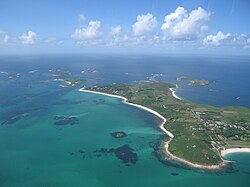Islands by type and name
Offshore and inshore islands


To group islands by geographical region, sort the table by "Island Group/Location" (click the icon by the column heading).
Inland islands
There are numerous islands within freshwater lakes and rivers in England. They are most numerous in the Lake District but other concentrations occur within the Norfolk Broads, some major reservoirs and principal rivers.
In the Lake District
To group islands by lake, sort the table by "Lake" (click the icon by the column heading).
In the River Thames
- See: Islands in the River Thames
Inland islands elsewhere in England
To group islands by location, sort the table by "Location" (click the icon by the column heading).
| Name | Location |
|---|---|
| Newark Island [1] | River Trent |
| Alney Island | River Severn |
| Big Island | Carsington Water |
| Bird Island | Stocks Reservoir, Lancashire [2] |
| Bridgemarsh Island | River Crouch, Essex |
| Denny Island | Chew Valley Lake |
| Flat Island | Carsington Water |
| Haddiscoe Island (or Chedgrave Island or simply 'The Island') | Between River Waveney, River Yare and New Cut [3] |
| Horseshoe Island | Carsington Water |
| Lady Island | Hornsea Mere |
| Millfields Island | Carsington Water |
| Peasholm Island | Peasholm Lake, Scarborough |
| Pleasure Island | Hickling Broad, Norfolk |
| Sailing Club Island | Carsington Water [4] |
| Shiningford Island | Carsington Water |
| Stanlow Island | Merseyside, Manchester Ship Canal |
| Swan Island | Hornsea Mere |
| Willow Island | Stocks Reservoir, Lancashire |

